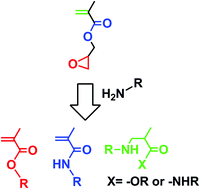Synthesis of hydrogel polyHIPEs from functionalized glycidyl methacrylate†
Abstract
Highly porous hydrogels based on functionalized glycidyl methacrylate (GMA) have been successfully prepared through the high internal phase oil-in-water emulsions. Pre-polymerization functionalization of the GMA monomer, porous structure and water uptake of highly porous hydrogels were investigated. The primary amine groups of tris(2-aminoethyl)amine (TRIS) or 1,2-diaminoethane (EDA) were found to react in three distinct reactions with the GMA, giving a mixture of methacrylate and methacrylamide as the major products with a small amount of the aza-Michael addition product. Elemental analysis revealed nitrogen loadings of 5.3 and 4.6 mmol g−1 for the hydrogel polyHIPEs prepared from the pre-functionalized GMA with TRIS and EDA, respectively. The aminated p(GMA)-based hydrogel polyHIPEs had the densities of around 0.16 g cm−3, void diameters of around 5.5 μm, water uptake up to 15 g g−1 and the specific surface area up to 55 m2 g−1. The water uptake and the specific surface area were found to be between 4 and 5 times higher than the corresponding values for the conventional GMA-based polyHIPEs prepared from the water-in-oil HIPEs. These results demonstrate a highly efficient pre-polymerization functionalization method for the preparation of GMA-based hydrogel polyHIPEs.


 Please wait while we load your content...
Please wait while we load your content...